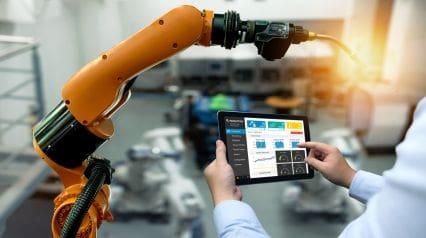What are IoT Devices?
IoT devices are gadgets and digital tools that utilize the Internet of Things (IoT). The IoT is a network of various devices that can communicate with each other, send data, and even receive instructions. This allows the devices to work semi or fully autonomously while still effectively accomplishing their assigned job. An IoT device is connected to the internet and uses this network to communicate with other connected devices, which can improve the functionality of various homes, offices, and any space.
Examples of IoT Devices
That said, even if IoT has been growing in popularity, many people are still confused about how this technology applies in the real world. So, below, we’ll look at four different IoT devices that are connected to the internet, how they work, and how they benefit various organizations:
RFID Tags and Readers
RFID tags and readers are common IoT devices used by various organizations. Similar to barcodes, RFID tags provide a host of information that RFID readers may then scan and open. Unlike barcodes, however, RFID tags and readers are a type of near-field technology, meaning they don’t require a direct line of sight. This allows the readers to scan RFID tags much more efficiently and provides them with essential information.
This is typically used by organizations for asset tracking and management. For example, workers can scan the RFID of a particular product and view its complete history, progress, and even where the product is supposed to be delivered.
Smart Meters
Another common IoT device is a smart meter. These are common utility meters like electricity and water meters. Like a regular utility meter, these devices track consumption of water, energy, and other utilities. However, they can communicate with other devices like computers so they can feed your system with information about how much you’re consuming. This allows you to make data-driven decisions to cut down on consumption and drive down costs.
In fact, these meters can even work in tandem with your entire utility system. So, if consumption is high, it can automatically limit power or resources being sent to certain areas. That way, you never use too much of your utilities, keeping your operational expenses as low as possible.
Smart Robots
Industrial robots and collaborative robots (cobots) have come a long way in recent times. Nowadays, these robots can connect to the internet and perform their job based on the data they receive from other devices. That way, they can easily be reprogrammed for certain tasks (e.g., watering crops in smart farms) and automatically shift to jobs where the robots would be the most helpful.
This can greatly improve operations, as it ensures that cobots and robots are utilized to their fullest potential. However, it’s important to have the right system around the robots that feeds the appropriate data they need to perform properly.
Environmental Monitoring Devices
Arguably among the most common IoT devices on the market right now are environmental monitoring devices. These IoT devices keep track of temperature, humidity, and air quality in various locations. This is great for materials that require specific conditions like food and other raw materials.
Explore SafetyCulture Monitoring Solution
Utilize advanced sensor technology to monitor assets, automate vital alerts, implement actions, and report urgent issues.
Talk to an expertThese sensors are typically connected to the internet. That way, they can send notifications to the appropriate people whenever there’s an anomaly in temperature, humidity, or air quality. You can even program various devices to work in tandem with each other so that the HVAC and environmental control systems adjust according to the data from the sensors.
In addition, the information gathered from these IoT devices can be applied to various tasks, including food safety monitoring and predictive maintenance.




